Related Research Articles

The Maryland Transit Administration (MTA) is a state-operated mass transit administration in Maryland, and is part of the Maryland Department of Transportation. The MTA operates a comprehensive transit system throughout the Baltimore-Washington Metropolitan Area. There are 80 bus lines serving Baltimore's public transportation needs, along with other services that include the Light Rail, Metro Subway, and MARC Train. In 2021, the system had a ridership of 44,612,100, or about 124,900 per weekday as of the first quarter of 2022. With nearly half the population of Baltimore residents lacking access to a car, the MTA is an important part of the regional transit picture. The system has many connections to other transit agencies of Central Maryland, Washington, D.C., Northern Virginia, and south-central Pennsylvania : WMATA, Charm City Circulator, Regional Transportation Agency of Central Maryland, Annapolis Transit, Rabbit Transit, Ride-On, and TransIT.

MARC is a commuter rail system in the Baltimore–Washington metropolitan area. MARC is administered by the Maryland Transit Administration (MTA) and operated under contract by Alstom and Amtrak on track owned by CSX Transportation (CSXT) and Amtrak. In 2021, the system had a ridership of 1,291,900, or about 6,200 per weekday as of the first quarter of 2022, much less then the pre-pandemic daily ridership of 40,000 per weekday.
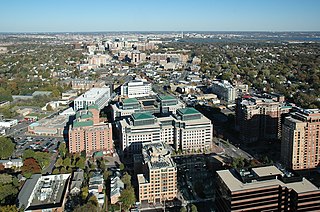
In urban planning, transit-oriented development (TOD) is a type of urban development that maximizes the amount of residential, business and leisure space within walking distance of public transport. It promotes a symbiotic relationship between dense, compact urban form and public transport use. In doing so, TOD aims to increase public transport ridership by reducing the use of private cars and by promoting sustainable urban growth.
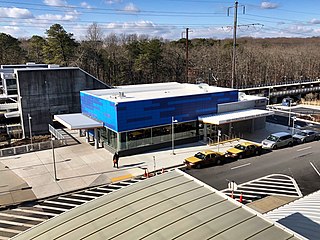
BWI Airport Station is an intermodal passenger station in Linthicum, Maryland near Baltimore–Washington International Airport (BWI). It is served by Amtrak Northeast Corridor intercity trains, MARC Penn Line regional rail trains, and several local bus lines.
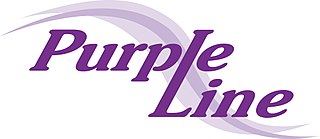
The Purple Line is an under-construction 16.2-mile (26.1 km) light rail line intended to link several Maryland suburbs of Washington, D.C.: Bethesda, Silver Spring, College Park, and New Carrollton. The line will also enable riders to move between the Maryland branches of the Red, Green, Yellow, and Orange lines of the Washington Metro without riding into central Washington, and between all three lines of the MARC commuter rail system. The project is administered by the Maryland Transit Administration (MTA), an agency of the Maryland Department of Transportation (MDOT), and not the Washington Metropolitan Area Transit Authority (WMATA), which operates Metro.

The Metro SubwayLink is a rapid transit line serving the greater area of Baltimore, Maryland, in the United States, and is operated by the Maryland Transit Administration. More than half of the line is underground, and most of the line outside the central city is elevated or at surface grade. In 2021, the line had a ridership of 1,667,400, or about 4,700 per weekday as of the first quarter of 2022.

Baltimore Light RailLink is a light rail system serving Baltimore, Maryland, United States, as well as its surrounding suburbs. It is operated by the Maryland Transit Administration. In downtown Baltimore, it uses city streets. Outside the central portions of the city, the line is built on private rights-of-way, mostly from the defunct Northern Central Railway, Baltimore and Annapolis Railroad and Washington, Baltimore and Annapolis Electric Railway. In 2021, the system had a ridership of 2,718,100, or about 7,800 per weekday as of the first quarter of 2022.

The Red Line was a planned east–west mass transit light rail line for Baltimore, Maryland. The project had been granted federal approval to enter the preliminary engineering phase and the Maryland Transit Administration had spent roughly $300 million in planning, design and land acquisition. The project was projected to cost roughly $1.6 billion, $900 million of which was guaranteed funding by the federal government. Maryland Governor Larry Hogan declared on June 25, 2015 that he would not provide state funds for the project. Governor Hogan shifted $736 million of state funding to roads in suburban areas.
The Green Line is a proposed mass transit line for the Baltimore, Maryland area in the United States. It is still in the planning stages and its construction is not guaranteed.
CMTA may refer to:
The Baltimore Transit Alliance (BTA) was an initiative of the Greater Baltimore Committee, bringing together businesses and non-profit organizations to advocate for better public transportation in Baltimore, Maryland. The BTA's priorities included construction of the Red Line, a new east–west light rail line through Baltimore and the Green Line, an extension of the existing Baltimore Metro Subway; enhanced transit connections between Baltimore and Washington; improved local bus service in the Baltimore region; and regional cooperation among the local jurisdictions that comprise the region.
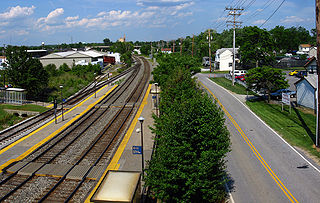
Savage is a passenger rail station on the MARC Camden Line between Union Station and Baltimore's Camden Station. It is officially located at 9009 Dorsey Run Road in Savage, Maryland, however Dorsey Run Road runs over the railroad tracks as well as Brock Bridge Road, which runs along the south side of the tracks and is a street-level with the station. The station straddles the line between Howard County and Anne Arundel County, with the southbound platform and parking garage located in Howard County and the northbound platform in Anne Arundel County.
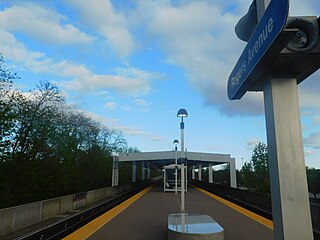
Rogers Avenue station is a Metro SubwayLink station in Baltimore, Maryland. It is located in the Woodmere area, and is the fifth most northern and western station on the line, with approximately 900 parking spaces.

The Central Pennsylvania Transportation Authority, doing business as rabbittransit, is the mass transit service of York and Adams counties in Pennsylvania and oversees the transportation needs of Columbia, Cumberland, Franklin, Montour, Northumberland, Perry, Snyder and Union counties. The agency currently operates 15 fixed routes within York County and 4 routes in Adams County, express bus routes from Gettysburg to Harrisburg and from York to Harrisburg and Towson, Maryland.
Otis France Rolley is the former planning director of Baltimore, serving from July 2003 until 2007. He was a Democratic candidate for mayor of Baltimore in 2011.
The Yellow Line is a mass transit line proposed by the Baltimore Regional Rail Plan in March 2002 for the Baltimore, Maryland area. It would begin at Columbia Town Center in Columbia, Maryland, and end in Hunt Valley, Maryland at Shawan Road.

Ioanna Morfessis is an American business woman and economic development strategist and practitioner. She has been an innovator in economic development programs and strategies since her first post in the profession, founding four economic development organizations and establishing programs and tools that became models for communities across the U.S.
The Baltimore Community Foundation (BCF) is a community foundation created by and for the people of Baltimore to serve the current and future needs of the Baltimore region.
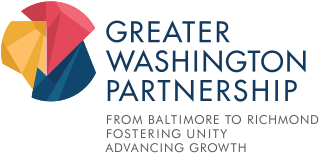
The Greater Washington Partnership is a civic alliance of the region’s leading employers who are committed to fostering unity and making the Washington–Baltimore metropolitan area the most inclusive economy in the nation.
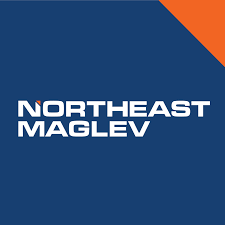
Northeast Maglev or The Northeast Maglev, LLC, is a private U.S. company proposing a Superconducting Maglev (SCMAGLEV) train system in the Northeastern United States. Using technology developed by the Central Japan Railway Company, the Northeast Maglev would provide 15-minute service between Baltimore and Washington, D.C. with an intermediate stop at BWI Airport, and ultimately connect major Northeast metropolitan hubs and airports with a goal of one-hour service from Washington, D.C. to New York City.
References
- ↑ "Central Maryland Transportation Alliance". Archived from the original on 2014-07-27. Retrieved 2014-07-17.
- ↑ Central Maryland Transportation Alliance website.
- 1 2 Central Maryland Transportation Alliance website video.
- ↑ Baltimore Examiner, Oct. 19, 2008; Maryland Daily Record, Oct. 17, 2008.
- ↑ Maryland Transit Administration, Sept. 2008.
- ↑ Central Maryland Transportation Alliance website release, Feb. 24, 2009.